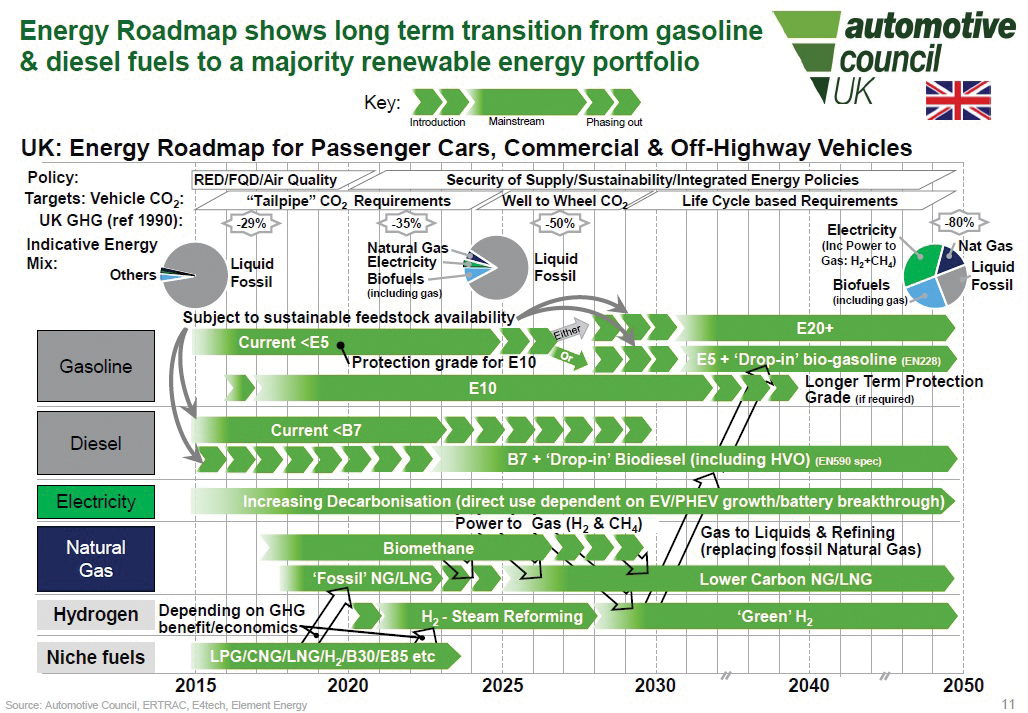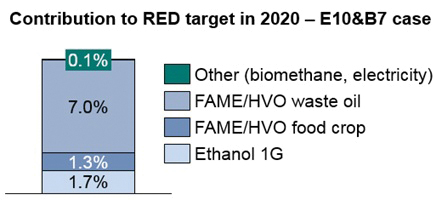Transport Energy
LowCVP developed a number of key reports and a roadmap focused specifically on transport energy in the UK. The Automotive Council developed a fuels roadmap based on this report as well as the views of its members and two notable reports which looked at transport energy at a European level, produced by European Road Transport Research Advisory Council (ERTRAC) and a consortium which commissioned a report by E4tech.

The Automotive Council fuels roadmap is available online from Ricardo’s website.
Road Transport Fuels for the UK
The Fuels Roadmap highlights a number of key themes and can be downloaded by clicking here..
Electrification of vehicles is likely to become a mainstream offer in the decade from 2020, providing there are advances in electricity storage technology and assuming adequate grid capacity. This must be matched with reductions in the carbon intensity of the grid if transport is to make a contribution to long term carbon reduction goals.
Beyond 2020, the European Commission’s transport goals are also expected to begin driving the volume introduction of Zero Emission Vehicles, potentially through CO2-free urban logistics and the phasing out of conventionally fuelled cars in cities before 2050.
In terms of commercial vehicles, efficiency gains will be an essential component of advances in the 2020–2030 timeframe with an increasing use of hybridised and some full electric (battery electric and fuel cell) powertrains for specific applications.
There is sufficient sustainable ethanol to enable vehicles to move to a higher blend than E10 gasoline. This also brings potential for further efficiency gains if vehicle engines are manufactured to take advantage of potential, higher octane levels from higher ethanol content.
Methane and biomethane will have a key role to play in road transport in the time horizon to 2030. This will require a robust strategy to ensure that the potential well-to-wheel emissions benefits are realised. The report also sees a role for LPG and the intriguing potential for bio-LPG.
Renewable Fuels 2020
Element Energy was commissioned to look at how the UK could meet the Renewable Energy Directive transport targets for 2020 as part of its fuels roadmap. Key conclusions and recommendations were:
In order to comply with Renewable Energy Directive transport target, maximising the use of fuels which count double towards the target-used cooking oil (UCO), and fuels from other waste material, as a feedstock for B7 biodiesel will be needed and will reduce the risk of unintended consequences such as indirect land-use change (ILUC). However, this approach is not without its challenges; maximising the use of UCO and waste sources requires close scrutiny to ensure fuel quality and vehicle operability are maintained under all conditions.
The deployment of E10 petrol will also be required. The UK produces ethanol with a low ILUC risk and the investments in these production facilities should be supported. These facilities also provide a route to advanced fuels.
Vehicles powered by renewable electricity are unlikely to make sufficient inroads in the time available to meet the 2020 target even with multiple counting of the EV contribution. However, encouraging the deployment of electric and biomethane vehicles, together with the increasing range of niche options available is key to helping alleviate the risks of reliance on E10 and B7 to meet the target.
Encouraging the development and deployment of advanced and drop-in fuels as early as possible will also help alleviate short term reliance on E10 and B7 made from food crops. Advanced fuels include hydro treated vegetable oil (HVO), biomass to liquid (BTL) and ethanol made from waste or ligno-cellulosic material (E2G).
Download the Element and Energy RED Scenario Report.

Source: Options and recommendations to meet the RED transport target. Element Energy, 2014